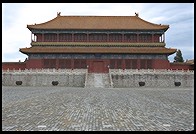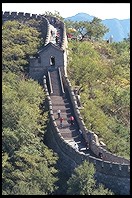
|
Timeline History
|

|
Home : Travel : China : Timeline
- 130,000-900,000 BC (Middle Pleistocene): Homo erectus walks the
earth near Peking, leaving remains to be found at Zhoukoudian cave
("Peking man").
- 6,000 BC: "Neolithic revolution" initiates the Bronze Age.
- 1,000 BC: Yu establishes first Chinese dynasty, the Hsia, which
lasts for seventeen kings.
- 1,550-1,050 BC: Shang dynasty becomes first dynasty to leave
historical records.
- 1,111 BC: Royal house of Chou wins decisive battle against last
Shang king, initiating the Chou dynasty.
- 770-476 BC: Ch'un-ch'iu ("Spring and Autumn") period of the Chou
dynasty. Chou royal line is broken, feudal system in decline.
- 551 BC: Philosopher and teacher Kongfuzi (Confucious) is born. The
archetypal Chinese wise man, he elaborates a philosophy of filial
piety, respect for education, and a meritocratic view of government.
- 221 BC: Ch'in ruling house survives Ch'un-ch'iu power struggle and
initiates the first imperial dynasty, the Ch'in. Shih huang-ti unifies
China and becomes first Chinese emperor. Defensive walls in north of
China are connected and strengthened into what will become the Great
Wall of China.
- 202 BC: Han dynasty founded by Liu Pang, the first long lasting
imperial dynasty.
- 220 AD: Single Han empire split into the Three Kingdoms when the
last Han emperor cedes authority to Wei, the son of a warlord.
Shortly after, two other military leaders declare themselves emperor,
Shu-Han in the interior, and Wu, in the south. The Three Kingdoms
period is marked by civil war.
- 263: Wei conquers Shu-Han.
- 265: A general of the Ssu-ma clan overthrows the Wei dynasty,
founding the Hsi Chin (Western Chin) dynasty.
- 280: Hsi Chin armies conquer the Wu dynasty, reuniting China under
a single rule and initiating a short period of peace.
- 304: Liu Yuan, a northern barbarian cheftain, conquers northern
China. North China splits into a collection of barbarian states known
as the Sixteen Kingdoms.
- 317: Six Dynasties period. Southern China is ruled by a succession
of royal families. Considered one of the most culturally creative
periods in Chinese history.
- 577: The Pei Chou (Northern Chou) unify Northern China.
- 581: The general Yang Chien usurps the northern throne and founds
the Sui dynasty.
- 589: Yang Chien invades the south, and once again China is
reunited, this time under a barbarian ruler.
- 617: Li Yuan, one of various rebel leaders, marches on the capital
and deposes Yang-ti, the current Sui emperor. A Sui prince, Kung-ti,
is put on the throne as a puppet emperor, while Yang-ti is demoted to
"retired emperor". One year later, Yang-ti dies and Li Yuan takes the
throne for himself, beginning the T'ang dynasty.
- 624: The T'ang defeat the other rebel leaders, who have been
causing trouble contending for the throne. All of China is reunited
and pacified.
- 874: A wave of peasant uprisings begin that eventually topple the
T'ang dynasty.
- 907: Fall of the T'ang dynasty gives rise to the Five Dynasties
and Ten Kingdoms period. Five short-lived dynasties subsequently
control northern China, while ten stable regimes control sections of
southern and western China.
- 960: Chao K'uang-yin (better known as T'ai-tsu), a military
leader, stages a coup and usurps the throne from the Wu-tai, last of
the Five Dynasties. Under the Pei Sung (Northern Sung) dynasty, the
civil service system achieves its most sophisticated form.
- 965: T'ai-tsu begins program of reunification by taking Szechwan.
- 978: The Wu-Yueh, last of the Ten Kingdoms in the south,
surrenders without a struggle, completing reunification under the Sung
dynasty.
- 1127: After several cycles of reform and antireform, extravagant
spending by the rulers, and an alliance with the Manchurian Juchen
that goes awry, the Juchen invade the Chinese capital and demand heavy
ransoms. The court pays them off, but realizing that the emperor's
resources have been exhausted, the invaders usurp the throne and found
the Nan Sung (Northern Sung) dynasty.
- 1276: After four decades of effective defense from the Nan Sung,
Mongol invaders outflank the defenders to the west and take the Sung
capital.
- 1279: Mongol invasion topples the Sung dynasty when the boy
emperor and a loyal minister commit suicide by jumping into the sea,
beginning the Mongolian Yuan dynasty under Kublai Khan.
- 1368: A weak emperor and increasing militarization of Chinese
society encourages the formation of rebel movements following
disastrous flooding in 1351, which culminate with the fall of the
Mongol emperor. An ex-Buddhist priest, Chu Yuan-chang, becomes the
Hung-wu emperor, founding the Ming dynasty, one of the stablest and
longest dynasties in Chinese history.
- 1592: Japanese forces under Toyotomi Hideyoshi invade Korea. Ming
China comes to its support, but the war drags on and precipitates a
military decline in China.
- 1624: Beleagured by partisan politics, the T'ien-chi emperor
grants totalitarian power to his favorite eunuch, Wei Chung-hsien, who
begins a bloody purge of reformist officials.
- 1616: Nurhachi becomes the leader of the Manchus and initiates an
invasion of China, gaining control over northeastern China by 1621.
- 1644: Li Tzu-ch'eng, a domestic rebel, captures the capital. The
Chinese emperor commits suicide. The Manchu forces help Ming forces to
remove Li Tzu-ch'eng, but take the throne for themselves. The Ch'ing
(Qing) dynasty is declared by Dorgon, the regent for Nurhachi's
grandson, who becomes the first Ch'ing emperor.
- 1839: Lin Tse-hsu is named Imperial commissioner for an anti-opium
campaign. He seizes and destroys 20,000 chests of smuggled British
opium in Canton. Fighting breaks out between China and Britain.
- 1840: Rear Admiral George Elliot sets sail with 16 British
warships to demand a lifting of the ban on opium. No agreement is
reached.
- 1841: Elliot's forces attack Canton and hold it for ransom for
$6,000,000. The Cantonese counterattack and kick off the First Opium
War.
- 1842: Henry Pottinger, Elliot's successor, takes Nanking and
forces the Treaty of Nanking, with China giving up concession after
concession to British trade. Antiforeign sentiment grows.
- 1851: Hung Hsiu-ch'uan fails his civil service examination, goes
into a trance and discovers that he is the Son of God. He declares the
T'ai-p'ing T'ien-kuo, the Heavenly Kingdom of Great Peace, and kicks
off the Taiping rebellion, the bloodiest civil war in history.
- 1856-1858: A British-registered ship, the Arrow, is seized and its
Chinese crew charged with smuggling. A joint force of British and
French led by Lord Elgin is sent to occupy Canton, beginning the Arrow
War. In 1857, the Anglo-French forces occupy Canton; the next year,
they march on Tientsin. Four Tientsin treaties are signed,
establishing foreign diplomats in Peking and freedom of movement for
Christian missionaries.
- 1859-1860: The Western signatories to the Tientsin treaties show
up to get their treaties signed, but are repulsed by the guns at Ta-ku
fort. In 1860, allied forces march on Peking. In response to the
torture and execution of several emissaries, Lord Elgin orders the
destruction of the Summer Palace.
- 1894: Japanese Navy clashes with a Chinese fleet over issues of
Korean independence, starting the Sino-Japanese War.
- 1896-1898: Bands of I-ho ch'uan (Righteous and Harmonious Fists),
or Boxers, stir up anti-Christian hysteria and begin the Boxer
Rebellion.
- 1898: Kuang-hsu emperor initiates the Hundred Days of Reform, a
series of radical reform decrees. The empress dowager Tz'u-hsi puts
the stop to that, has the Emperor detained, and takes over the reins
of government.
- 1900: The Boxers beseige the foreign legation quarter in
Peking. Empress dowager Tz'u-hsi declares open war and calls on all
Chinese to attack foreigners. The rebellion is put down by an
expedition of the foreign powers.
- 1908: Tz'u-hsi and the Emperor die, and the Hsuan-t'ung emperor is
crowned. His father, the Prince Chun, becomes regent and initiates a
series of reforms.
- 1911: Chinese Revolution. Yuan Shih-k'ai is recalled from
retirement to take command of army to put down the revolution. He
negotiates with the revolutionaries, with the hope of being instituted
as the head of a new government, but is disappointed when Sun Yat-sen
is appointed president of the new republic.
- 1937-1945: Sino-Japanese War
- 1945: Civil war begins, Nationalists vs. Communists.
- 1949: People's Republic of China established with the victory of
the Communists.
- 1966-1976: Cultural Revolution
Chinese History in Contemporary Literature and Film
Chinese history can appear to the layman as an uninterrupted series of
dynasties, periods, invasions and reunifications, all mostly
indistinguishable from one another. It can be useful to turn to the
portrayal of Chinese history in contemporary literature and film to
provide a more narrative perspective than a list of dates and
dynasties. Alternatively, a passing familiarity with history can
provide a sense of context with which to better enjoy popular works
set in Chinese history.
The Judge
Dee books of Robert Hans Van Gulik serve admirably as an example
of works that bring Chinese history to life. They are a set of mystery
novels and short stories detailing the work of Judge Dee, a T'ang
dynasty magistrate (magistrates were responsible for bringing
criminals to justice as well as judging them). They are good reads and
work well as mysteries, as well as being interesting historical
perspectives. Judge Dee was a historical person, but Van Gulik's
stories are based on stories written about him from the Ming dynasty.
Entering more recent times, George MacDonald Fraser's Flashman
and the Dragon is an entertaining work of historical fiction which
follows its protagonist, Harry Flashman, a cowardly and surprisingly
peripatetic Victorian gentleman soldier, as he wins undeserved kudos
for being in the right places at the right times. Part of a series,
this book covers his adventures in China at the time of the Taiping
rebellion as he travels along with Elgin's 1860 Peking expedition,
culminating with the destruction of the Summer Palace. Noted
historical personages making appearances are the Taiping leader Hung
Hsiu-ch'uan and the not-yet Empress Dowager Tz'u-hsi. Fraser's books,
although obviously works of fiction, are filled with a wealth of
historical detail backed up by copious footnotes and references to
primary sources.
Covering even more recent ground is the film The Last Emperor, which is
the story of the life of Aisin-Gioro Pu Yi, the last emperor of
China. It is interesting mostly for its portrayal of Imperial life
within the Forbidden Palace, and the conditions within Communist China
during the Cultural Revolution.
In the category of works that are perhaps better appreciated by being
placed in a historical context (rather than being noted for historical
accuracy) are many period pieces of Chinese and Hong Kong cinema, most
of which are excuses to watch martial arts virtuosos at work. Among
the most popular of these are the films about Wong Fei-Hung, which
include Jet Li's Once Upon a Time in China series, and Jackie Chan's
Drunken Master 2. Wong Fei-Hung was a historical person, a martial
arts master, teacher, and physician. He lived from 1847 to 1924, so
any films involving him would be set in the declining days of the Qing
empire and mostly involve plots against the hated Manchu rulers or the
Western barbarians of Victorian England. There have been over one
hundred films involving Wong Fei-Hung, and it is in fact these films
which have taken a moderately famous teacher, one of many, and turned
him into a folk hero. There are many many other kung fu films set in
the Qing dynasty, probably both because being more recent they would
be more accessible to the audience, and because any story of struggle
against Manchu Imperial rule fits in nicely with Chinese national
pride and Communist values.
Text and pictures Copyright
2000 Philip Greenspun.
PhotoCD scans by
Advanced
Digital Imaging.
philg@mit.edu



